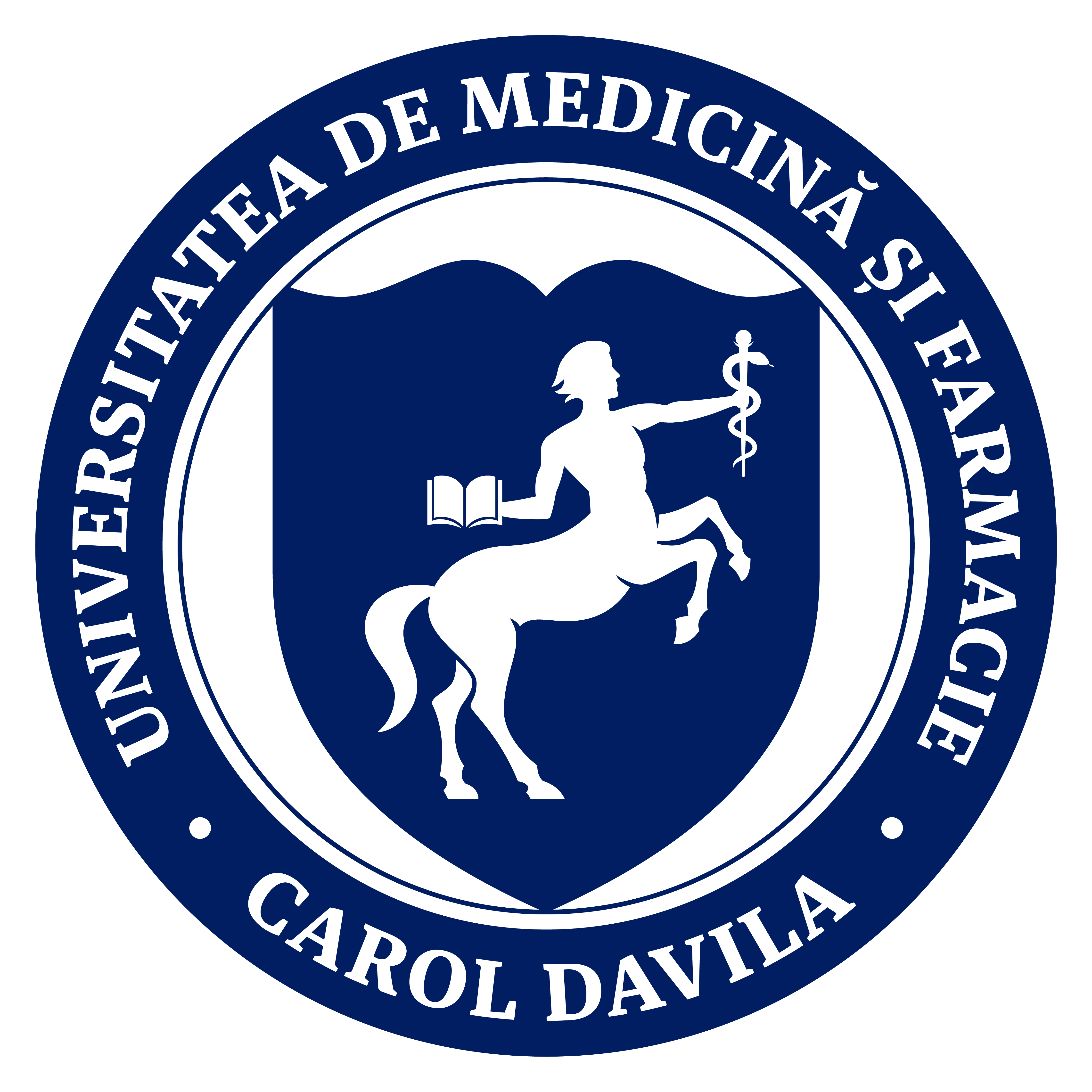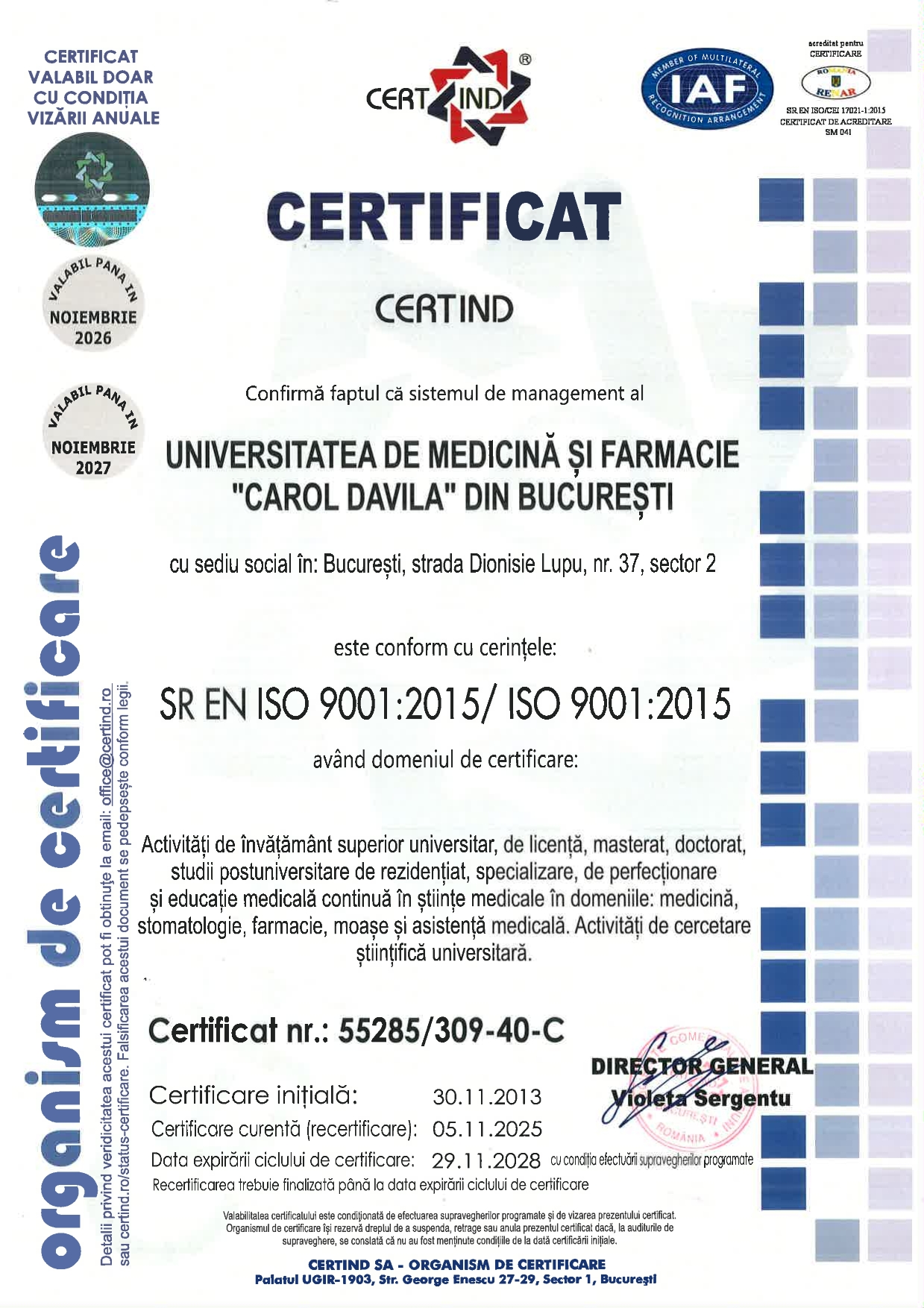Discipline - Ophthalmology - Bucharest Emergency University Hospital
- List of academic staff
- Brief history of the discipline
- Description of medical activity
- Description of education and research activity
- Useful information for specialists in training
- Useful information regarding postgraduate courses
- Useful information for PhD
- Key words of subdomains of interest for research activity
- Research projects
- Scientific work
| Professor | Popa-Cherecheanu Daniela Alina, PhD | tenured |
| Associate Professor | Pirvulescu Ruxandra Angela, PhD | tenured |
| Associate Professor | Dascalu Ana-Maria, PhD | tenured |
| Associate Professor | Iancu Raluca Claudia, PhD | tenured |
| Head of works | Alexandrescu Cristina Mihaela, PhD | tenured |
| Head of works | Geamanu Aida, PhD | tenured |
| Head of works | Mitulescu Traian Costin, PhD | tenured |
| Head of works | Coroleuca Ruxandra, PhD | tenured |
| Assistant Professor | Nicolae Vanessa Andrada, PhD | tenured |
| Assistant Professor | Totir Madalina Corina, PhD | tenured |
| Assistant Professor | Bucsan Radu Gheorghe, PhD | fixed term |
| Assistant Professor | Toma Marian Eduard, PhD | fixed term |
| Assistant Professor | Bostan Mihai, PhD | tenured |
| Assistant Professor | Deleanu Dan George, PhD | tenured |
| Assistant Professor | Popescu Maria-Viorela, PhD | tenured |
The beginnings of the Romanian School of Ophthalmology is built around 1880 in Bucharest’s Coltea hospital, hospital facility with tradition in Romanian medicine.
The service by itself to grant hospital ophthalmologic and outpatient assistance, as well as forms of education – discharged. hospitalised, training and specialization – gradually appear over the years. Being well defined after 1900.
In 1922, the Romanian Society of Ophthalmology was founded and in 1924, the first Romanian Congress for Ophthalmology took place and it was destined to Trahom. Later, the Ophthalmology Magazine is founded and it reflects the vast scientific and didactic activity of the clinic until today.
Following the reorganization of medical assistance in 1978, the transfer of the clinic to Municipality Hospital (today Bucharest Emergency University Hospital) was performed – under the coordination of Prof. Dr. Doina Pop de Popa.
The mentioned traditions have allowed the continuation of the ophthalmology activity, resulting also in surgical interventions with the latest techniques – cataracts, glaucoma, strabismus, tumors, eyelids; the cataract surgery is the most common ophthalmic surgery.
Ophthalmology is a medical-surgical branch that deals with the study of ocular diseases and periocular adjacent structures. Numerous medical conditions can have ocular expression and affliction, such as diabetes, cardiovascular, neurological, rheumatological, hematological and endocrine diseases, the ophthalmologist having an important diagnostic role but also a therapeutic one.
Currently, the discipline includes many subspecialisations – ophthalmopediatry and strabismus, oculoplastic surgery, cornea and refractive surgery, cataract, glaucoma, vitroretinian surgery, medical retina, neuroophthalmology.
In the department of Ophthalmology and Clinical Ophthalmology S.U.U.B., there are the following activities::
- complete ophthalmologic consultations including:
- Determing visual activity, examination of the anterior segment of the eyeball, examination of the posterior segment of the eyeball, ocular tension measurement, quantitative and qualitative determination of tear secretion, computerized determination of diopters.
- investigations and functional explorations:
- Manual and computerized perimetry, ocular and orbital ecography, ocular biometry, angiofluorography, retinophotography, tomography in optical coherence.
- ocular surgery ( surgery of the cataract, glaucoma, strabismus, vitro-retina)
As a result of the existent equipment in the clinic, we have the possibility of diagnosis, treatment and monitoring the evolution of the majority ocular conditions: glaucoma disease, cataract, refractive defects, inflammatory diseases of the anterior and posterior pole, venous thromboses, arterial occlusions, detachment of retina, strabismus, retinopathies, burns of the eye and eyelids, neuropathies, tumors etc.
The courses are aimed for sixth year students from the "Carol Davila" University of Medicine and Pharmacy and have the following curriculum:
- Ocular Refraction
- Eyelids
- Orbit
- Conjunctiva
- Lacrimal apparatus
- Ocular Motility
- Sclera
- Cornea
- Uvea
- Crystalline
- Glaucoma
- Retina
- The Optic Nerve
- Injuries of the eyeball and the annexes
- Ophthalmic manifestations in general diseases
Practical works are structured as following:
- Examination of visual function (Visual acuity, visual sight, chromatic sense)
- Examination of ocular refraction. Optical correction (subjective and objective determination of refraction, lenses types, optical correction principles)
- Examination of the anterior pole of the eyeball (exam in daylight, exam with biomycroscope, colouring with fluoresceine)
- Examination of the posterior pole of the eyeball (ophthalmoscopy methods, eye elements, notions of retinal semiology)
- Examination of ocular annexes (orbit, eyebrows region, eyelids, lacrimal apparatus)
- Examination of the oculomotor balance (ocular statics and dynamics, binocular vision, strabic deviation)
- Examination of the ocular tension. Gonioscopy (techniques of gonioscopy and tonometry, indications , contraindications, interpretations)
- Paraclinical explorations (angioflorography, electroretinography, evoqued visual potentials, biometry)
- Explorartion of ocular imaging (ecography, OCT, HRT, CT, RMN)
- Medication in Ophtalmology
The assessment of students is performed through quiz tests, the final mark being calculated considering the practical examination mark, depending on the work during the internship.
Curriculum for the ophthalmology specialty is found on the Ministry of Health website
(link: http://rezidentiat.ms.ro/curricule/oftalmologie.pdf)
An extremely important side of the educational activity that we perform represents the relationship with the resident doctors.
Regarding this, we consider the development of the following professional sides:
- participation to courses and presentations organized by the discipline, developed in accordance with the requirements and the level of training of the audience, focused on specific elements of the Ophthalmology specialty, on both medical and surgical teams.
- study of diagnostic and therapeutic algorithms;
- courses and demonstrations of surgical technique – both theoretical and practical on ophthalmic surgery simulator machines;
- support for residents in order to graduate the exams for obtaining European diplomas of ophthalmology specialty physicians;
- increase the residents’ interest for scientific research and their involvement in research projects and writing scientific papers ;
- encouraging participation to national and international ophthalmology conferences and congresses.
- Courses with themes which concern the early detection of glaucoma
- Courses for assimilating new technologies (OCT examination)
- Courses for family doctor (glaucoma, diabetes, arterial hypertension)
The doctoral studies represent the university education form offered to medical degree graduates who wish to obtain additional competences in scientific research field.
The doctorate will allow knowledge and application of methodology and research techniques, learning communication skills or publishing at the highest level.
Ophthalmology offers numerous opportunities for clinical and experimental research, having the advantage of developing multiple subspecialties in the discipline (pediatric ophthalmology, refractive surgery, cataract and glaucoma surgery, vitroretinal surgery, neuroophthalmology).
Doctoral studies cover a period of four years and include compulsory courses in the first year, such as Bioethics, Biostatistics, Research and Publishing Methodology, Legislation, Pedagogy, followed by scientific research activity.
- Glaucoma
- Uveites
- Laser in Ophtalmology
- Cornean Crosslinking
- Dry Eye Syndrome
- „Technical study on functional performances and parameters required for automatic dosing systems, continuous monitoring and computerized display of information regarding the proper execution of ophthalmologic treatments’’ (Acronym-SIDOMOOFTALMO)
-
- Project coordinator Associate Professor Dr. Liliana Mary Voinea.
- Financing – state budget, Ministry of Education, Research and Youth, Partnership in Priority Domains Project (Funding contract for projects execution nr. 71-022/18.09.2007).
- Contracting authority, National Center of Programs Management, contractor Polytechnic University – Bucharest – Research Center – Development for Mecatronics (PB – CCDM). Project value for 2007– 26.000 RON
- Complex integrated system of health and prevention – EDUSAN, National Program of Excelency Research, began in june 2005, Associate Professor Dr. Liliana Mary Voinea – member in research team
- Romanian Academy, nr.145/16.08.2007, Dr. Rusu Mugurel, Associate Professor Dr. Liliana Mary Voinea - member in research team. Project value – 20.000 Ron – contracts not made yet.
- "Modeling and simulation of bacterial efflux pump using advanced laser methods" (AMPLE) (2012), Research project Nr. 85/2012 Partnerships – Main Investigator – Prof. Dr. Liliana Voinea
- "New ocular implant with biocompatibility and high proliferation", Project PN-II-PT-PCCA-2013-4-0584, highest score 100 points
- Histopathological findings concerning ocular melanomas.Costache M, Pătraşcu OM, Dumitru A, Costache D, Voinea LM, Simionescu O, Sajin M., Rom J Morphol Embryol. 2014;55(2 Suppl):649-53.
- Immunohistochemistry of choroidal melanoma: nestin, CD34 and CD117/c-kit labelling
- Alexandra Diana Vrapciu, Mugurel Constantin Rusu, Liliana Mary Voinea, Rom J Morphol Embryol 2014, 55(2).437-442
- CD146- and CD105-positive phenotypes of retinal ganglion cells. Are these in situ proofs of neuronal regeneration,Vrapciu AD,Rusu MC, Voinea LM, Corbu CG.
- Infliximab eye drops treatment in corneal neovascularization., Voiculescu OB,Voinea LM., J Med Life. 2015 Oct-Dec;8(4):566-7
- Acute anterior uveitis and other extra-articular manifestations of spondyloarthritis., Mitulescu
- TC, Popescu C, Naie A, Predeţeanu D, Popescu V, Alexandrescu C, Voinea LM, J Med Life. 2015 Jul-Sep;8(3):319-25.
- Palkovits S, Told R, Schmidl D, Boltz A, Napora KJ, Lasta M, Kaya S, Werkmeister RM, Popa-Cherecheanu A, Garhöfer G, Schmetterer L. Regulation of retinal oxygen metabolism in humans during graded hypoxia. Am J Physiol Heart Circ Physiol. 2014;307:H1412-8.
- Palkovits S, Told R, Boltz A, Schmidl D, Popa Cherecheanu A, Schmetterer L, Garhöfer G. Effect of increased oxygen tension on flicker-induced vasodilatation in the human retina. J Cereb Blood Flow Metab. 2014;34:1914-8
- Told R, Schmidl D, Palkovits S, Boltz A, Gouya G, Wolzt M, Witkowska KJ, Popa-Cherecheanu A, Werkmeister RM, Garhöfer G, Schmetterer L. Antioxidative capacity of a dietary supplement on retinal hemodynamic function in a human lipopolysaccharide (LPS) model. Invest Ophthalmol Vis Sci. 2014;56:403-11.
- Schmidl D, Schmetterer L, Garhöfer G, Popa-Cherecheanu A. Pharmacotherapy of Glaucoma. J Ocul Pharmacol Ther. 2015;31:63-77.
- Palkovits S, Lasta M, Told R, Schmidl D, Werkmeister RM, Popa Cherecheanu A, Garhöfer G, Schmetterer L. Relation of retinal blood flow and retinal oxygen tension during stimulation with diffuse luminance flicker. Sci Reports 2015 in press



